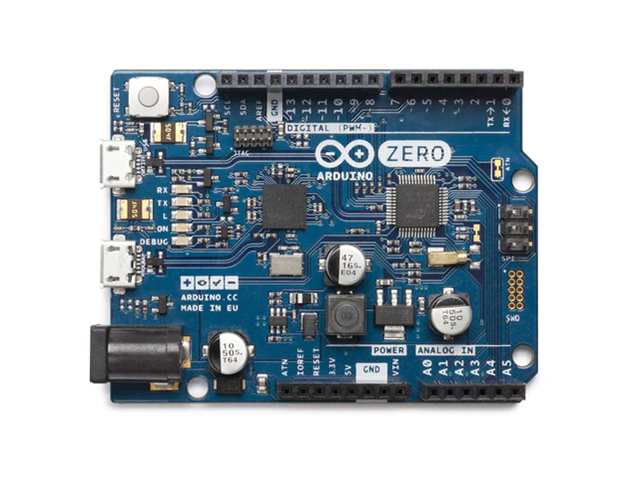The Arduino Zero is a versatile development board that combines the power of a 32-bit ARM Cortex-M0+ core with Arduino’s ease of use. Here are the key features and details about the Arduino Zero:

- Microcontroller: It uses the Atmel (now part of Microchip Technology) ATSAMD21G18, which is a 32-bit ARM Cortex-M0+ microcontroller running at 48 MHz.
- Memory:
- Flash Memory: 256 KB
- SRAM: 32 KB
- Operating Voltage: 3.3V (It’s important to note that unlike many Arduino boards, the Zero operates at 3.3V logic levels.)
- Input Voltage (recommended): 5-12V
- Digital I/O Pins: 20 (of which 10 provide PWM output)
- Analog Input Pins: 6 (12-bit ADC)
- Analog Output Pins: 1 (10-bit DAC)
- DC Current per I/O Pin: 7 mA
- Clock Speed: 48 MHz
Key Features:
- Debugging Capabilities: The Arduino Zero includes a built-in debug port, allowing for advanced debugging with tools like Atmel Studio or the Arduino IDE with the appropriate add-ons.
- Native USB: It has a native USB port, which means it can emulate USB devices like keyboards, mice, or MIDI devices without the need for a separate USB-to-serial chip.
- Real-Time Clock (RTC): It includes an RTC for timekeeping, which is not standard on many Arduino boards.
- Hardware Serial: There are multiple hardware UARTs for serial communication.
- Interrupt Handling: The ARM Cortex-M0+ core provides better interrupt handling capabilities compared to older 8-bit AVR microcontrollers.
- Power: It can be powered via the micro USB port or with an external power supply. It has an onboard voltage regulator to provide the 3.3V operating voltage.
- Programming: While it can be programmed with the Arduino IDE like other Arduino boards, it also supports more advanced programming environments like Atmel START for those looking to leverage its full potential.
Unique Capabilities:
- 32-bit Processing: The 32-bit architecture offers better performance for complex projects, especially those involving mathematical operations or requiring more memory.
- Advanced Connectivity: The USB capabilities allow for direct communication with computers, making it suitable for USB HID projects or as a USB device.
- Debugging: The built-in debug port is a significant feature for developers needing to debug code at a lower level or in real-time.
- Low Power Options: It has multiple power-saving modes, making it suitable for battery-powered projects.
Use Cases:
- Prototyping: The Arduino Zero is ideal for projects that require more processing power or advanced features than what standard 8-bit Arduinos can offer.
- Education and Advanced Learning: It’s excellent for teaching or learning about 32-bit microcontrollers, ARM architecture, and advanced programming techniques.
- IoT and Connectivity: Its USB capabilities and processing power make it suitable for Internet of Things (IoT) projects, especially those involving USB or MIDI communication.
- Real-Time Applications: Projects that require precise timing or real-time control can benefit from the Zero’s capabilities.
The Zero is a simple and powerful 32-bit extension of the platform established by the UNO. The Zero board expands the family by providing increased performance, enabling a variety of project opportunities for devices, and acts as a great educational tool for learning about 32-bit application development. The Zero applications span from smart IoT devices, wearable technology, high-tech automation, to crazy robotics. The board is powered by Atmel’s SAMD21 MCU, which features a 32-bit ARM® Cortex® M0+ core. One of its most important features is Atmel’s Embedded Debugger (EDBG), which provides a full debug interface without the need for additional hardware, significantly increasing the ease-of-use for software debugging. EDBG also supports a virtual COM port that can be used for device and bootloader programming.
Warning: Unlike most Arduino boards, the Zero runs at 3.3V. The maximum voltage that the I/O pins can tolerate is 3.3V. Applying voltages higher than 3.3V to any I/O pin could damage the board.
The board contains everything needed to support the microcontroller; simply connect it to a computer with a micro-USB cable or power it with a AC-to-DC adapter or battery to get started. The Zero is compatible with all the shields that work at 3.3V and are compliant with the 1.0 Arduino pinout.
You can find your board warranty information here.
Note
Arduino boards based on AVR microcontrollers get a reset and restart sketch execution each time the Serial Monitor of the Arduino Software (IDE) is opened. This is also the mechanism used to upload sketches to these boards. This board is different: when the Zero is connected through the Programming Port and you open the Serial Monitor, the board does not automatically reset and the sketch loaded keeps running. To restart the sketch you need to press the reset button on the board itself.
Getting Started
In the Getting Started section, you can find all the information you need to configure your board, use the Arduino Software (IDE), and start to tinker with coding and electronics. To keep your Zero’s Bootloader up to date, the the Update Procedure explains what you should do each time there is a new Arduino SAMD Boards release.
Need Help?
- On the Software on the Arduino Forum
- On Projects on the Arduino Forum
- On the Product itself through our Customer Support
Tech specs
| Microcontroller | ATSAMD21G18, 32-Bit ARM® Cortex® M0+ |
| Operating Voltage | 3.3V |
| Digital I/O Pins | 20 |
| PWM Pins | 3, 4, 5, 6, 8, 9, 10, 11, 12, 13 |
| UART | 2 (Native and Programming) |
| Analog Input Pins | 6, 12-bit ADC channels |
| Analog Output Pins | 1, 10-bit DAC |
| External Interrupts | All pins except pin 4 |
| DC Current per I/O Pin | 7 mA |
| Flash Memory | 256 KB |
| SRAM | 32 KB |
| EEPROM | None. See documentation |
| LED_BUILTIN | 13 |
| Clock Speed | 48 MHz |
| Length | 68 mm |
| Width | 53 mm |
| Weight | 12 gr. |
